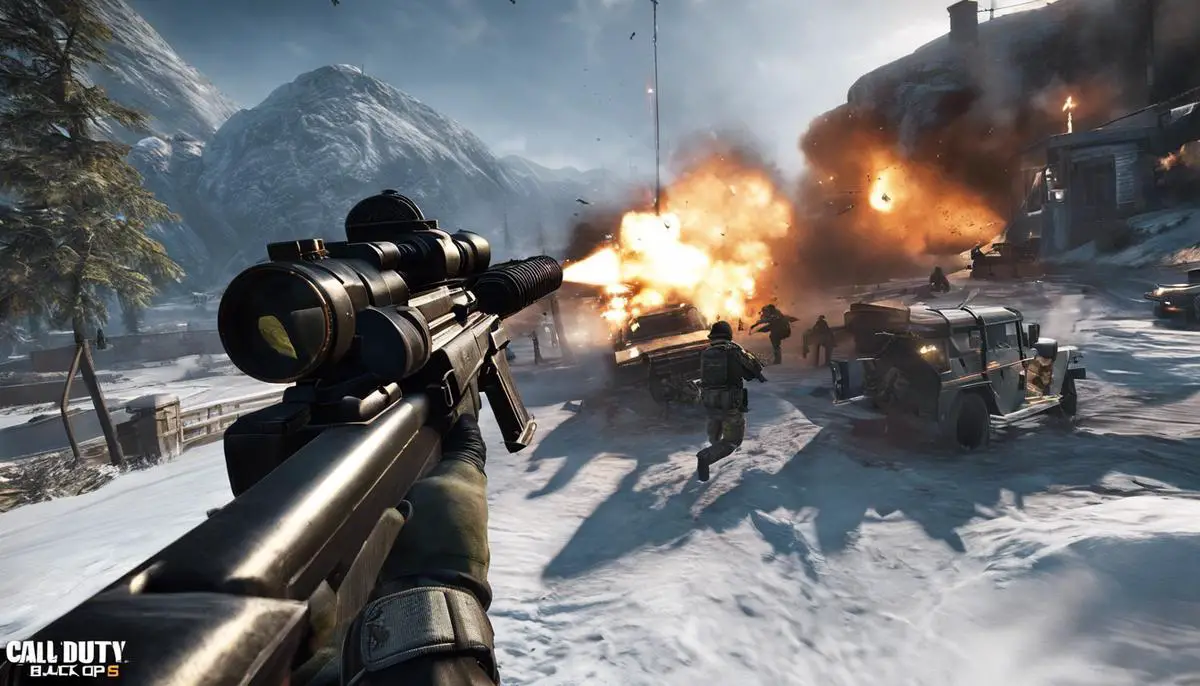Embarking on a virtual odyssey within the geopolitical setting of the Cold War, Call of Duty: Black Ops provides a gaming environment that truly immerses gamers in its intricately designed maps. Featuring an amalgamation of advanced technology and ingenious craftsmanship, each map is tailored to usher in a unique gaming experience. From the realistic ambiance mirroring the tensions of the era, to the strategic layout incentivizing tactical gameplay, each detail offers rewarding interactions. Venture with us as we explore the innovative and technical marvels that make Call Of Duty: Black Ops an epic saga, and trace how these advancements may set the trajectory for future gaming map designs.
Innovative Features of Black Ops Maps
A defining element in video gaming is the game world: its realism, design, and integration of technology. An excellent case study of this is the Call of Duty: Black Ops series. Black Ops maps stand out in the gaming tech world because of their attention to detail, notable design techniques, and active use of emerging technologies. They seamlessly blend reality and game world to create an experience that transcends traditional gaming limits.
Designing a map for a game like Call of Duty: Black Ops is an intricate process, requiring a careful blend of strategy, realism, and aesthetics. Black Ops maps are notably compact and densely packed, thus focusing on fast-paced, close-quarters combat. These maps include vertical structures that alter the field and atmosphere of the game, offering various strategic options for players. The design sense showcases a desire to push the boundaries of traditional gaming.
Real-world inspirations form the base of Black Ops maps. These come alive with meticulous attention to detail – in landscaping, architecture, and even the smallest props. It’s a testament to the hard work and dedication of the game developers and designers. They have effectively managed to bring every corner, every building, and every path to life, resulting in believable action-packed environments.
Apart from the immersive design and real-life inspirations, what truly sets Black Ops maps apart is their astute use of the latest technology. For instance, one word: Ray Tracing. This graphical technology simulates the physical behavior of light to produce a high degree of visual realism. It’s now a major tool in gaming, adding to the depth, shadows, and reflections within the game environment.
With the technology of Ray Tracing and the advantages of high-definition graphical rendering, Black Ops maps are incredibly detailed and vibrant. They extend beyond simple light sourcing and shadow mapping—thanks to this advanced lighting model, Black Ops maps can bring a stunning level of visual fidelity that’s unprecedented in multi-platform games.
Moreover, players can positively impact the performance and graphics on their end. With custom optimizations and settings adjustments, gamers can experience these outstanding maps as per their preference. Whether one prefers smoother gameplay or higher resolution visuals, the technology incorporated in these maps allows for that versatility.
To sum up, the outstanding elements that make Call Ops Black: Ops maps standout in the world of gaming tech are their intricate design, close resemblance to real-world locations, and savvy use of advancing technology. Their attention to detail, along with the adaptation and integration of emerging trends, push the limits of traditional gaming and set new standards. It’s fascinating to envision what the future holds for such gaming tech-masterpieces.

Interactivity and Realism in Black Ops Maps
While discussing the functioning of technology in the immersive and realistic universe of Call of Duty: Black Ops, it is essential to delve into the specifics of their advanced tech systems.
Cod: Black Ops has revolutionized gameplay through the calculated integration of Artificial Intelligence (AI) in its maps. Deep learning and machine learning algorithms have been used creatively to develop NPC (Non-Player Character) behavior that mimics human unpredictability. The AI-driven opponents or allies on Black Ops maps are programed to act and react appropriately in real-time situations, offering a lifelike experience. AI technology has allowed game developers to create characters that learn from their environment and players, cultivating an immersive, unpredictable, and hence, gripping gaming experience.
Another technological gem Black Ops flaunts is spatial audio technology. This technology enables the surrounding audial environment of the game to respond to players’ actions, facilitating a multi-dimensional sensory experience. The sound of an approaching enemy, the echo of firearm, or even the rustling of foliage are all nuanced audial cues calculated to provide a heightened sense of realism and player involvement.
The advancements don’t stop there. The game developers of Black Ops have further pushed the envelope with their inventive use of photogrammetry. This process of scanning real-world objects and environments has become the gold standard for achieving an unparalleled degree of visual realness. It enables game designers to recreate exact replicas of real-life locales or objects within the game environment. This technology is vital in constructing a believable and immersive atmosphere that connects players to the game on a deeper level.
The incorporation of advanced physics engines within Black Ops maps is the technological underpinning for gameplay that respects and adheres to real-world principles. These engines determine how objects move, fall, or collide, based on laws of physics, elevating the credibility of each action and therefore, the overall gaming eco-system.
Finally, it would be remiss not to mention the influence of high-level scripting language that reigns over gameplay logistics in Black Ops. Scripting languages like Python or Lua bestow game developers with the power to design intricate game events, conditional behaviors, or plot developments. They orchestrate game functionalities contributing to the making of realistic, responsive, and engaging maps within Call of Duty: Black Ops.
Technology, undoubtedly, has been the secret sauce in Call of Duty: Black Ops, continually pushing the boundaries and shaping the evolution of the gaming experience. The advancements of the Black Ops series portray a promising future for video games – where technology and creativity meet to deliver awe-inspiring, hyper-realistic, and highly interactive experiences.

Technical Challenges in Building Black Ops Maps
Building upon the intricate craftsmanship of Call of Duty: Black Ops maps, a certain set of technical challenges arises. Being at the forefront of the gaming industry doesn’t come without a sprinkling of hurdles to conquer.
Endowed with AI sophistication, Call of Duty: Black Ops games have non-playable characters (NPCs) exhibiting behavior that is more authentic than ever. However, integrating Artificial Intelligence into the game isn’t as straightforward as it may seem. To create NPCs that move, react, and respond convincingly, developers employ deep learning and machine learning algorithms. These algorithms aid in simulating intricate behavior patterns, but their implementation necessitates a balance between realism and playability. Overly intelligent NPCs could turn the game into a punishingly hard experience, detracting from the enjoyment.
Next breakthrough auditory realm, spatial audio technology, emerges in the Black Ops series. Sounds in the game come from directions corresponding to their sources within the 3D game environment, immersing players into the detailed maps with a realistic audial experience. This integration is challenging as it involves processing large amounts of data in real-time, ensuring audio accuracy relative to player position, and synchronizing it with the unfolding gameplay events.
One can hardly ignore the striking visuals when discussing Black Ops maps. This accomplishment is attributed to photogrammetry, a process that helps in creating immense visual realism. However, while creating accurate textures and ultra-realistic 3D models is key, making them work smoothly within the game’s engine is another challenge. Detailed assets can cause slower load times and performance drops if not properly optimized, creating a tight rope for developers to walk.
Physics in the world of Black Ops maps go beyond mere visuals. Advanced physics engines are employed to simulate real-life object movements and interactions. This realistic portrayal requires careful balance between actual physics principles and gameplay requirements. Excessively detailed physics could put additional computational strain on the game, potentially leading to a choppy performance.
Last but not least, scripting is fundamental to the storyline and gameplay logistics. High-level scripting languages are used to coordinate complicated sequences, dialogues, and in-game events. However, the complexity escalates when branching storylines and player choices come into the picture. They can lead to a vast array of potential outcomes, complicating the scripting process enormously as developers strive to forethink and plan various scenarios.
All in all, these technical feats that define the Black Ops series don’t come without their share of challenges. But in the world of gaming, it’s these very challenges that push the envelope, captivating gamers worldwide and fueling the surge for gaming technology to new heights.

Comparing Black Ops Maps Across Different Editions
One fabulous transformation through the different editions of Black Ops maps is undoubtedly their AI integration, where programmers harness the power of artificial intelligence to achieve character behaviors that feel increasingly realistic, dynamic, and complex. The AI-controlled Non-Player Characters (NPCs) show continuous evolution and pose significant challenges for the developers. It is not simply about programming a particular conduct; it’s about establishing adaptive systems that can respond intelligently to a player’s actions. Advanced machine learning algorithms are the secret sauce here, forming a sophisticated web of logical decisions, each intricately hinged on player input and game context.
The aspect of delivering a realistic audial experience to players brings in spatial audio technology to the rescue. But integrating this real-time immersive sound system that can create sound effects which seem to come from all around the player, including above and below, comes with its own set of hurdles. The technology must process vast amounts of data in split-seconds to accurately match sounds with gameplay actions and quickly switch between different sound frequencies and intensities. It’s a careful juggling act that pushes the boundaries of both software and hardware capabilities.
Visual representation is another significant transformation in Black Ops maps. Photogrammetry, the advanced process of capturing realistic visuals from high-resolution images, is being applied more in recent installations. However, optimizing performance while keeping the visuals at a high standard is a challenging task. Developers have to harmonize stunning graphic detail with an intense, fast-paced gameplay that must flow smoothly without any distractions.
Physics, the backbone of most realistic movements and interactions in games, is now handled by advanced engines that authentically mimic real-world forces like gravity, friction, and elasticity. However, there’s always a tricky balance. On the one hand, developers aim for maximum physical accuracy which can be computationally expensive; on the other hand, they need to ensure seamless gameplay, which requires optimization and simplified physics calculations.
High-level scripting languages have become the cornerstone of game development. They dictate the gameplay logistics and events, including how NPCs react to environmental changes and player actions. Technical complexities arise from the need to co-ordinate and sequence these interactions to create a cohesive gaming experience. What’s more, factoring in multiple player choices, twists in storylines and events, and different game endings, these scripts can quickly turn into massively complicated mazes.
In conclusion, while the evolution of Black Ops maps has seen some stunning technological advancements, each has come with its unique set of challenges and solutions. It’s this never-ending cycle of innovation, problem-solving, and optimization that keeps pushing gaming technology to new frontiers. And therein lies the beauty and complexity of the interplay between technology and creativity in the unmatched domain of video gaming.

Future Technology Trends in Gaming Maps
Exploring the Infinite Potential of Virtual Reality
Virtual Reality (VR) sits on the gateway of widespread adoption in the gaming industry and it holds immense potential in revolutionizing Call of Duty: Black Ops maps. Using VR, players could potentially have a wholly immersive experience, stepping “within” the map and interacting more deeply with the game’s world. VR would inherently give rise to a new perspective when it comes to vertical structures and dense maps, offering the player a first-hand experience that’s unmatched in terms of realism.
The Advent of Haptic Technology
Adding to the immersive potential of VR, the inclusion of haptic technology could take tactile feedback to a new level in Black Ops. Haptic suits and gloves can interpret and simulate a host of physical experiences. Imagine sensing the recoil of a firearm, feeling the blast wave following an explosion, or even the vibration of a passing vehicle. This level of tactile immersion could drastically alter the experience within Call of Duty Black Ops maps, making the gameplay more intense and engrossing.
The Role of 5G and Cloud Gaming
The soon-to-become-mainstream 5G network, with its super-high-speed and ultra-low-latency, could offer seamless and uninterrupted gameplay, especially for multiplayer modes. There would be a significant reduction in lag, thereby offering a smoother and more cohesive experience. With the advent of 5G, cloud gaming too will likely take root, which would not only make gaming more accessible but could also considerably accelerate the incorporation of advanced technology on platforms like Call of Duty: Black Ops.
The Implementation of Augmented Reality
While Virtual Reality displaces the player into a different world, Augmented Reality (AR) brings that world to the player. Though the AR technology is pretty nascent, its potential impact in an interactive game like the Call of Duty: Black Ops can be profound. Incorporating AR-visors in the gameplay could portray an interactive HUD in real-world environment or even showcase in-world elements in the player’s space, blurring the line between the in-game and real world. It’s likely to enrich the gaming experience and the appeal of Black Ops maps.
Potential of Quantum Computing
Quantum computing, though a bit farther along the horizon, holds immense promise for the gaming industry. In terms of Black Ops, quantum computing could potentially enhance real-time rendering to extraordinary levels, deliver sophisticated AI opponents, or create much more realistic and dynamic environments.
Much like the rapid evolution of Call of Duty: Black Ops maps, the ever-evolving technology landscape too opens a world of limitless possibilities. New tech-trends always find their way into gaming, constantly innovating and positing fresh challenges. It keeps the gaming landscape exciting and drives game-makers, like those behind the Call of Duty: Black Ops series, to push boundaries and unlock new gaming elevations for gamers to explore. So here’s to tech enthusiasts, game lovers and tech-maximizing game creators! The future holds fascinating prospects, and one can only imagine the leaps and bounds the world of Black Ops maps is destined to make in this technology-powered world.

Traversing through different editions of Call of Duty: Black Ops, it is fascinating to observe the technical metamorphosis wherein each map upgrade has amplified the gameplay experience. Moreover, with the looming advent of artificial intelligence, augmented reality, and virtual reality in the gaming sphere, there is immense potential for future maps to lean into these technologies. As we stand on the cusp of this digital revolution, a tantalizing question remains – How will this technological evolution redefine the Call of Duty universe and gaming experiences overall? Looking ahead, it’s clear that Black Ops, a truly trendsetting franchise, stands poised to navigate these thrilling frontiers of gaming technology.
- Guide to Life Is Strange: True Colors Ch. 1 Choices - April 4, 2024
- Catching Spiritomb in Pokemon BDSP - April 4, 2024
- Mastering Life Is Strange: Key Choices in Chapter 1 - April 4, 2024
Visits: 0








